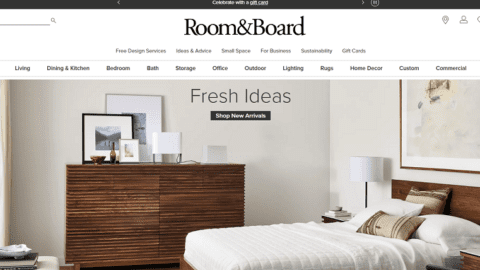After years of lockdowns and digital-driven behaviors, consumers’ actions have shown how crucial the store experience is to how they shop and interact with brands. So it’s no surprise that 47% of executives believe that store design and experience have become more critical to their brand strategy over the past year, according to Retail TouchPoints research.
But underneath this positive blanket statement are a lot of nuances. Consumers’ standards of what makes a “superior” brick-and-mortar experience have changed, and to make things even more complicated, these standards vary based on shoppers’ unique preferences, their needs at a specific point and time, the role that technology plays in their daily lives and, of course, how they live, work and interact in their everyday lives.
Brands and retailers realize there is no one-size-fits-all strategy for stores — and design teams are rising to the challenge by thinking more creatively and thoughtfully about how they can innovate through new formats, technologies and collaboration methods.
Retail TouchPoints asked experts across the store design, experience and technology realms to share the trends they believe will drive brick-and-mortar innovation. The panel of experts are:
Advertisement
- Nikki Baird, VP of Strategy for Aptos;
- Jamie Cornelius, Executive Creative Director at ChangeUp;
- Mardi Najafi, VP of Retail Strategy & Design at Figure3; and
- Melissa Gonzalez, Principal at MG2.
Trend 1: Engagement- and Inspiration-Driven Spaces Come into Focus
While a lot of retailers have embraced convenience-driven formats powered by digital technology, if merchants’ dramatic pivot away from self-checkout is any indication, some brands are realizing quickly that even the most robust technology cannot replace the power of human-to-human interaction and design-driven brand storytelling.
Cornelius: We’ve seen engagement-driven concepts with more community stores. Many of those were in response to the lack of connection people felt during the pandemic.
These types of stores instill a sense of belonging and connection, which in turn leads to brand loyalty. The H&M Move concept is a great example. What we haven’t seen as much of the last few years are inspiration-driven concepts. A great recent example of this type is the Tiffany Landmark in New York City. It’s a store you could spend hours in and still not see everything. I think we all hope that coming into the next few years we’ll see more brands willing to inspire their customers and understand the inherent value in that.
Gonzalez: The community-driven aspect is a big part of it. When we think about these tight-knit communities that exist and want to come together, the opportunity for a brand or retailer to be at the nucleus of that community-building is pretty significant. You can add to the stickiness of a brand, but also empower others to do good.
I think a lot of the time people are looking for brands and retailers to just stand behind something. And that’s just step one; not just saying it but also living it. Then the next step is to go beyond that to say you also plan on empowering consumers to be able to live those promises as well, whether that’s inclusivity, sustainability or giving back to the community.
Trend 2: Technology will Elevate Omnichannel Performance and Key Value Props
Nearly two-thirds (63%) of respondents to Retail TouchPoints’ annual Store Design & Experience Survey shared that better integrating technology into the experience was a top priority for them in 2023. As omnichannel capabilities become table stakes, brands and retailers will think more holistically and intentionally about how technology can support operational efficiency as well as immersive product interaction and brand engagement.
Baird: A lot of store renovation efforts are being driven by the expanded role of the store. For example, they need to support omnichannel services like BOPIS, ship-from-store and seamless returns. They also need to support a more mobile-enabled workforce that might need smaller, roller-cart type stations, rather than so much emphasis on fixed till cash wraps.
Technology is going to be central [to the store experience] — it has to be. If you want store associates out in front of customers more, you need mobile devices, you need a wealth of information available in the store associate’s hand. I think that pressure exists no matter the category, but it’s a stronger need for retailers selling high-consideration items, where store associates need a lot of information at hand to support the customer’s journey.
Gonzalez: We’re seeing so much of an evolution in how we live with technology; we are just interacting with environments in a very different way. That’s only going to further accelerate the expectations of consumers and technology adoption within retail environments. We’re going to have more comfortability with that, so I think that’s going to allow technology to live in the two buckets: improving operations and elevating the experiential layer.
Key examples that elevate that experiential layer are augmented reality, which is being brought into the store so people can feel confident in their purchases, and the fitting room, which can be a really good integrated moment, especially if I feel really good about the top that I’m wearing and you’re suggesting other items to me.
Trend 3: Store Design Teams Become ‘Experience Teams’
When a brand decides to open a new store, the design team cannot work within its own silo. Although the creative aspect is especially important, designers and visual merchandising teams need to work closely with their colleagues in marketing, IT and business strategy to ensure all decisions align with the bigger picture. This is a new reality for typical projects, according to Cornelius, and it is why her firm has changed its vernacular from “store design” to “experience design.”
Cornelius: We’ve found the orchestration of disciplines to be necessary to create impactful change. For a successful design, everyone should be working towards the same goal. First, an executive sponsor with a vision and the ability to bring teams together, usually a CXO or CEO, is necessary. Second, clear goals and metrics need to be set for each department that not only define how they will achieve their individual success, but the collaborative success of the whole project.
For instance, it is much easier for operations to establish and reach success in one facet of the store. However, sometimes the success of one area (i.e. operational efficiencies) has a negative effect on another (i.e. customer experience). Nothing is more difficult than seeing the problem from another’s vantage point — this is where the executive sponsor plays a critical role. It is their job to understand where those “compromises” need to happen to benefit the design as whole and drive tangible results.
Gonzalez: You really need that trifecta — the store design team, the business development and marketing team, and then the IT team to an extent, depending on what kind of technology integration is happening. Having all these people together allows you to bring together the art, the science and the business.
Having that lens is critical because you’re having a more comprehensive view of what’s possible. You’re pushing things forward with the art, but it’s backed by science and data. And then of course, the business lens of it to make it scalable.
Baird: Please, please invite technology people to the store design table. Retailers have gotten better about thinking about simple things like power accessibility or creating WiFi shadows around fixtures and things like that, but there are still far too many unintended consequences that come out of store design because they did not think through tech requirements up front.
Trend 4: Store KPIs Will Evolve to Reflect the Unique Role of Stores
Results from Retail TouchPoints’ 2023 Store Operations Survey indicate that retailers still largely use a mish-mosh of traditional key performance indicators (KPIs) to measure store performance, such as store revenue, in-store conversion rates, same-store sales and foot traffic. Baird notes that using too many store metrics creates a lack of focus, and that retailers need to instead use pointed metrics that reflect stores’ distinct roles in the omnichannel experience.
Baird: Store KPIs really need to change. They are far too centered on the store as a stand-alone entity and not as part of the overall customer experience, which means they tend to drastically undervalue the store’s contribution to that customer experience. There also tends to be a lot of ‘metric creep,’ where retailers throw another metric on the pile and over time the pile becomes so huge as to be useless.
I think one of the most important metrics to use is “sales per engagement minute” — for every minute that a customer is engaged with a retailer, whether that’s time on the site or time spent with an employee in the store, how much spend does that drive? It’s a great number because it lets you look at that by channel, but also across channels and touch points. Once you have a baseline, you can do a lot with that number.
Gonzalez: In 2024, I believe we will see growing confidence in being able to track the attribution of in-store visits. We’ve been talking about this for a long time, but I think the tools are getting better, and the more technology is being integrated into the store, the more brands and retailers are being positioned to be able to leverage those insights.
To that end, I do think store KPIs need to embrace the halo effect a little bit more. A lot of the times the attribution is longer-tail, so you should ask and assess key questions:
- Did you attract new audiences?
- Did you open up the lifetime value of an existing customer?
- Are consumers returning products less often?
- Are they coming back to your brand more frequently than they did in the past?
- What kind of impact are you seeing across platforms when activations happen in a certain ZIP code?
Then, for entertainment-driven environments, that is where you’re leaning more into an emotional connection. And emotional connections are where you have more of that stickiness, right? Sales is the result, but the core of it is really that emotional connection.
Trend 5: Smaller Formats Inspire Big Innovation
Over the past year, we saw retailers like Macy’s double down on small-format strategies. Others experimented with more localized, short-term experiences designed to drive engagement and gather pointed consumer data. In 2024, brands and retailers will embrace small and short-term formats to address very specific goals and communicate highly targeted messaging to resonate with defined audiences.
Gonzalez: Brands and retailers will lean into smaller formats with more specific points of view, [including] a focus on localization, and then leveraging technology like endless aisle tools to fully utilize the footprint and satisfy consumers’ specific needs.
We’re going to see a mix of these stores and pop-ups, which brands will lean into as brand ignition moments. For example, Sorel had an anniversary coming up and they were across Nordstrom locations, but they don’t currently have their own brand in stores anymore. They utilized this pop-up to really be an immersive brand moment to ignite the brand, leverage it across platforms and create content.
You’re going to see brands think through the physical retail opportunity more holistically — being a touch point in the consumer journey. Every market is not the same, so showing up purposefully at significant times of the year is a good investment.
Najafi: As many retail stores had to shut their doors for good, and many others struggled with lower traffic, reduced sales and payroll cuts, small-format stores have become more popular with retailers.
Strategies such as small-format stores, temporary pop-ups and store-in-store can help retailers target specific audiences, experiment with new brand concepts and maximize reach while minimizing overhead.
When brands and retailers take this approach, it equates to lower rents, fewer employees and less inventory on hand. Overall, it means lower overhead and less risk, while gaining the opportunity to test and learn before committing to a permanent location.
These smaller-format stores allow retailers and brands to get closer to their target group and open locations in areas where they wouldn’t otherwise have the ability to do so if it weren’t for the reduced store size.
Trend 6: Loss Prevention Enters the Design Conversation
Earnings results from Dick’s Sporting Goods, Lowe’s and Target brought theft, and specifically organized retail crime (ORC), into the media spotlight. Although some note that the extremity of theft is difficult to measure, store operators are feeling the ripple effects: 39% of respondents to the RTP Store Operations Survey said reducing theft and shrink was a top challenge for them in 2023. As a result, all hands are on deck to implement new technologies and procedures — even store design teams.
Najafi: In-store theft may greatly impact the consumer experience. The organized thefts that have made headlines in 2023 will continue to be a problem for retailers in 2024. We are already observing a good share of retailers revisiting their shopper experience to tackle organized crime.
Everyday items are behind locked plexiglass, but technology will become a key driver of loss prevention efforts. For example, I expect the adoption of self-identification requirements, such as Amazon Go technology, to become more widespread. AI-enhanced video surveillance also will enable retailers to battle this dilemma.









